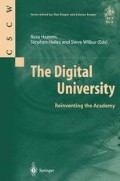Abstract
This chapter describes an evaluation of students’ experiences when seminars were conducted asynchronously using a text-based computer-conferencing system. It was anticipated that by conducting seminars which were not constrained by time or location this would encourage participation and would lead to higher quality contributions. A secondary aim of the evaluation was to investigate whether ‘quieter’ students were encouraged to interact more during the computer-mediated seminar discussions than they would normally do in face-to-face seminars. Examination of the transcripts revealed that there was 100% participation in the majority of discussions. The responses to an evaluation questionnaire indicated that the more introverted students were, the more they perceived the computer-mediated seminars as satisfying and enjoyable. The results also indicated that because there was no need to respond immediately, students were able to research an area in detail before contributing, leading to a more informed discussion. Other individual differences are examined, for example, communication and group working skills and preferences. In conclusion, although computer-mediated seminars can offer flexibility and encourage interaction, it is suggested here that individual differences may also play a part in their perception and use.
Access this chapter
Tax calculation will be finalised at checkout
Purchases are for personal use only
Preview
Unable to display preview. Download preview PDF.
References
Crook, C. (1994) Computers and the Collaborative Experience of Learning. Routledge.
Hoare, R. M. and Race, W. P. (1990) Computer conferencing: a versatile new undergraduate learning process. University Computing, 12, 13–17.
McCormick, N. B. and McCormick, J. W. (1992) Computer friends and foes: content of undergraduates’ electronic mail. Computers in Human Behavior, 8, 379–405.
Bresler, L. (1990) Student perceptions of CMC: roles and experiences. Journal of Mathematical Behaviour, 9, 291–307.
Sangster, A. (1995) World Wide Web–what can it do for education. Active Learning, 2, 3–8.
Browning, P. and Williams, J. (1995) The geology@bristol experience. Active Learning, 2, 34–38.
Hiltz, S. R. (1990) Evaluating the virtual classroom. Online Education: perspectives on a new environment. Harasim L. (Ed.). Praeger.
Riel, M. (1993) Global education through learning circles. Global Networks: computers and international communication. Harasim, L. ( Ed. ), MIT Press.
Hiltz, S. R. (1985) The Virtual Classroom: initial explorations of CMC systems as an interactive learning space. New Jersey Institute of Technology.
Bryson, M. and Steeples, C. (1995) The BT CMC in HE project. UCSG Summer Workshop on Conference Systems. Lancaster University, July.
Philips, G. M. and Santoro, G. (1989) Teaching group discussion via computer-mediated communication. Communication Education. 38, 151–161.
Duffy, C., Arnold, S. and Henderson, F. (1995) NetSem–electrifying undergraduate seminars. Active Learning. 2, 42–48.
Pickering, J. (1995) Teaching on the Internet is learning. Active Learning. 2, 9–12
Newman, D. R., Johnson, C., Cochrane, C. and Webb, B. (1996) An experiment in group learning technology: evaluating critical thinking in face-to-face and computer-supported seminars. Interpersonal Computing and Technology. 4, 1, 57–74.
Biggs, J. B. (1979) Individual differences in study processes and the quality of learning outcomes. Higher Education. 8, 381–394.
Riding, R., Rees, G. and Sharratt, M. (1995) Cognitive style and personality in 12-year old children. British Journal of Educational Psychology, 65, 113–124.
McCroskey, J. C. Oral communication apprehension: a re conceptualisation. Communication Yearbook. Burgoon, M. (Ed.), Sage, 6, 136–170.
Adrianson, L. and Hjelmquist, E. (1988) Users’ experiences of COM–a computer-mediated communication system. Behaviour and Information Technology. 7, 1, 79–99.
Oxley, J. (1995) The Effects of CMC on Communication Apprehension. Unpublished Undergraduate Thesis. Department of DEC, Bournemouth University.
Taylor, J. (1995) Electronic Mail, Communication and Social Identity. Unpublished PhD thesis. Department of Psychology, University of Portsmouth.
Newman, D. R. (1994) Computer supported co-operative learning. Groupware in the 21st Century, Lloyd, P. ( Ed. ), Adamtine Press, 211–219.
Dubrovsky, V., Kiesler, S. and Sethna, B. N. (1991) The equalisation phenomenon. Human-Computer Interaction, 6, 119–146.
McKee, A. (1995) The Usability of Inforum. Unpublished Technical Report. Department of DEC, Bournemouth University.
Author information
Authors and Affiliations
Editor information
Editors and Affiliations
Rights and permissions
Copyright information
© 1998 Springer-Verlag London
About this chapter
Cite this chapter
Taylor, J. (1998). Using Asynchronous Computer-Conferencing to Encourage Interaction in Seminar Discussions. In: Hazemi, R., Hailes, S., Wilbur, S. (eds) The Digital University. Computer Supported Cooperative Work. Springer, London. https://doi.org/10.1007/978-1-4471-0625-8_15
Download citation
DOI: https://doi.org/10.1007/978-1-4471-0625-8_15
Publisher Name: Springer, London
Print ISBN: 978-1-85233-003-3
Online ISBN: 978-1-4471-0625-8
eBook Packages: Springer Book Archive

